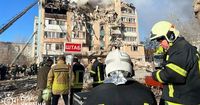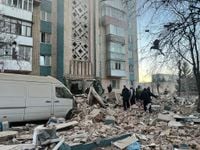In the early hours of November 19, 2025, Ukraine found itself under one of the most intense aerial barrages since the start of Russia's full-scale invasion nearly two years ago. According to Ukraine’s Ministry of Internal Affairs, at least 25 people—including three children—were killed and dozens more wounded as Russian forces unleashed a devastating combination of drones and missiles across the country. The attack, which President Volodymyr Zelenskyy described as "brazen," struck both eastern and western regions, with the western city of Ternopil suffering some of the deadliest consequences.
The Ukrainian Air Force reported that Russia fired more than 470 attack drones and 48 missiles overnight, including one ballistic missile and the remainder cruise missiles. The scale of the assault left much of the nation under air raid alerts, with explosions rocking the cities of Lviv and Ternopil in the west and Kharkiv in the northeast. Ukrainian state media described scenes of devastation, particularly in Ternopil, where two nine-story apartment blocks were hit, their upper floors torn away by the force of the blasts. Grey smoke and debris engulfed the city’s streets, as rescue workers combed through the ruins searching for survivors.
Ukraine’s State Emergency Service confirmed that at least 25 people lost their lives in Ternopil alone, with 73 others injured—including 15 children. The Interior Minister, Ihor Klymenko, shared images of the destruction, showing blown-out windows and entire floors of residential buildings collapsed into rubble. In Kharkiv, police reported that more than 10 apartment buildings, a school, a supermarket, and an ambulance substation were damaged, with at least 36 people injured, including two children.
These attacks triggered emergency power outages across several regions, as Russia continued its campaign to target Ukraine’s critical energy infrastructure. The Ukrainian Energy Ministry stated on Telegram, "Russia is once again attacking our energy infrastructure." The full extent of the damage remained unclear as authorities worked to restore essential services amid ongoing threats.
President Zelenskyy, who was traveling to Turkey on the day of the attacks in a bid to revive stalled peace talks, called on Ukraine’s allies to provide more air defense missile aid. "Every brazen attack against ordinary life shows that the pressure on Russia is insufficient. Effective sanctions and assistance to Ukraine can change this," Zelenskyy wrote in a social media post. His plea comes as he continues a diplomatic tour to shore up support, having recently signed an accord in France with President Emmanuel Macron that could see Kyiv acquire up to 100 fighter jets and additional military hardware, including drones.
The ripple effects of the assault were felt beyond Ukraine’s borders. Poland, Ukraine’s neighbor to the west, temporarily closed its Rzeszow and Lublin airports in response to the attacks, as the Polish Air Navigation Services Agency cited the need to ensure freedom of operation for military aviation. Polish and allied aircraft were scrambled as a precaution, underscoring the regional anxieties provoked by Russia’s escalating drone activity. In recent weeks, Poland has reinforced its air defenses along its roughly 530-kilometer border with Ukraine, a move echoed by other NATO members as drone incursions have violated the airspace of both Romania and Moldova. German Eurofighter jets, deployed under NATO’s enhanced Air Policing South, were activated after drone activity was detected in Romanian airspace, with Romanian partners taking over the mission.
Western Ukraine, and Ternopil in particular, had previously been spared the worst of Russia’s attacks compared to the embattled eastern front. The latest assault shattered that relative calm. Images shared on Ukrainian Telegram channels showed a tower block in Ternopil with its upper floors ripped open, flames licking through clouds of black smoke. The city, located about 200 kilometers from the Polish border, became a grim symbol of the war’s expanding reach.
As Ukraine reeled from the overnight strikes, it also launched its own attacks across the border. On November 19, Ukrainian forces fired four US-made ATACMS missiles at the Russian city of Voronezh. Russia’s Defense Ministry reported that all the missiles were intercepted by S-400 air defense crews and Pantsir missile and gun systems. Falling debris damaged the roofs of a retirement home, an orphanage, and a house, but no casualties were reported. The ministry published images of missile fragments and claimed that air reconnaissance identified the Kharkiv region as the launch site. Ukraine’s military described its use of US-supplied ATACMS missiles against targets inside Russia as a "significant development," reflecting a shift from previous restrictions that limited their use to Ukrainian territory.
Meanwhile, Ukraine’s domestic politics were rocked by a major corruption probe. On November 19, the Ukrainian parliament dismissed the country’s energy and justice ministers following allegations of a $100 million scheme involving the state nuclear agency. Both outgoing ministers denied any wrongdoing, but the controversy added to the country’s challenges as it seeks to sustain its war effort and maintain international support.
Diplomatic maneuvering also intensified. While President Zelenskyy sought to "reinvigorate negotiations" with Moscow, reports surfaced that the US Trump administration was preparing a 28-point peace plan for Ukraine in coordination with Moscow. The news, first reported by Axios, prompted a terse response from Ukrainian Foreign Minister Andrii Sybiha, who remarked, "This is how Russia’s 'peace plans' look like in reality." The Kremlin, for its part, declined to comment on the reports, with spokesperson Dmitry Peskov stating, "In this case, there is nothing new that we can inform you about." The plan reportedly draws inspiration from US mediation efforts in Gaza, which led to a ceasefire after two years of war, though Ukraine and its European backers have yet to publicly respond.
The European Union, meanwhile, unveiled a fast-track system to speed up the movement of tanks and troops across the continent, citing the need for defense readiness in the face of Russian aggression. EU foreign affairs chief Kaja Kallas emphasized, "The fast movement of Europe's militaries is essential for Europe's defense." The proposal includes over €17 billion in investments to upgrade key transport chokepoints from Poland to Portugal, aiming to ensure that Europe is not caught off guard by future threats.
As the dust settled in Ternopil and elsewhere, the sense of urgency was palpable. Ukrainian lawmaker Oleksiy Goncharenko summed up the mood, telling Al Jazeera, "Ukraine is a huge country and it is unfortunately impossible to completely stop all the missiles or drones. We are intercepting part of them but we definitely need more weapons, more systems, more air defense – that is what we are asking from our allies, and that's very important."
With winter looming and the specter of further attacks hanging over Ukraine, the events of November 19 serve as a stark reminder of the war’s evolving frontlines and the high stakes for both Ukraine and its Western allies. As diplomatic efforts continue and military strategies adapt, the resilience of ordinary Ukrainians remains at the heart of the unfolding crisis.

